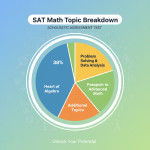Start Here: Why your Digital SAT score is a tool, not a verdict
Take a breath. Whether you’re a student holding a fresh score report or a parent helping to plan the next steps, it’s easy to let numbers feel like final judgments. They’re not. Your Digital SAT score is a powerful, objective data point — one of many — that helps you make informed choices about where to apply, where you have a strong chance, and where you might aim a little higher.
Colleges look at a range of factors: transcript GPA, course rigor, essays, recommendations, activities, interviews, and yes, test scores. The smart approach is to use your score to shape a balanced list of reach, match, and safety schools that align with your academic goals, financial considerations, and personal fit.

Understand what the Digital SAT score really means
The Digital SAT total score still ranges from 400 to 1600, split between two sections: Reading & Writing and Math. The College Board publishes percentiles and score interpretation guides that show where your score sits compared to other test takers. That percentile is one of the clearest ways to see whether a school is a reach, match, or safety for you.
Quick definitions
- Percentile: Your performance relative to other students. If you’re in the 75th percentile, you scored as well as or better than 75% of test takers.
- Middle 50% range: Many colleges publish the SAT range that covers the 25th–75th percentiles of admitted students. This is a practical predictor of competitiveness.
- Reach: Your score is below the school’s 25th percentile.
- Match: Your score falls inside the school’s 25th–75th percentile range.
- Safety: Your score is above the school’s 75th percentile.
Step-by-step: Turning a score into a strategic college list
Below is a practical workflow you and your student can follow. Treat it like a project: gather data, analyze, then plan.
1. Collect accurate score and percentile information
- Find the total score and section scores on the official score report.
- Note the percentile for the total score and each section — those tell you academic strengths and weaknesses.
- Use College Board’s BigFuture college profiles to find the published middle 50% SAT ranges for each college you’re considering.
2. Create a “reach-match-safety” spread — aim for balance
A good rule of thumb is to have roughly 3–5 safeties, 4–6 matches, and 2–4 reaches, but adapt those numbers to your family’s application budget, time, and emotional bandwidth.
- Safeties: Schools where your GPA and SAT score sit well above the 75th percentile, and financial fits are realistic.
- Matches: Schools where you fit comfortably inside the middle 50%.
- Reaches: Dream schools where your score is below the 25th percentile — apply if the school is an excellent academic or personal fit.
Example: Interpreting your score with a sample table
Here’s a simplified example showing how a student with a 1250 total SAT might categorize colleges. Replace the sample ranges with the real middle 50% ranges you find on BigFuture or College Board profiles.
| College | Published Middle 50% SAT | Where 1250 Falls | Category |
|---|---|---|---|
| State University A | 1100–1280 | Inside range | Match |
| Selective College B | 1400–1530 | Below 25th | Reach |
| Regional College C | 980–1160 | Above 75th | Safety |
| Public Honors College D | 1250–1440 | At 25th | Low Match / High Reach |
Reading the table: nuance matters
Seeing your score inside a college’s middle 50% doesn’t guarantee admission — but it does mean you’re academically competitive. Conversely, being below a college’s published 25th percentile doesn’t mean you shouldn’t apply. Admissions are holistic, and a compelling essay, strong grades in challenging courses, significant extracurricular leadership, or exceptional talent can shift the outcome.

Use section scores to refine majors and fit
Section scores can reveal particular strengths. If your Math score is much higher than your Reading & Writing, STEM programs may look more closely at your application; conversely, if your Reading & Writing shines, humanities and social sciences programs could be an excellent match. Some programs (e.g., engineering, economics) may weigh math heavily in their decisions, so tailor your list around where your section strengths will have the most impact.
Practical tip
- When a school publishes section-specific medians (some do), place more weight on the section most relevant to your intended major.
- If your intended major is undecided, aim for balance and emphasize a well-rounded application.
Other important signals beyond SAT numbers
Don’t forget the full context. These factors can elevate an application with a modest SAT score or dampen the advantage of a high score if they’re weak:
- GPA and course rigor (AP, IB, dual enrollment) — admissions officers often say grades over time are the best predictor of college success.
- Extracurriculars and leadership — depth matters more than a long list of clubs.
- Essays and letters of recommendation — they tell your story and show character, resilience, and intellectual curiosity.
- Demonstrated interest and special talents (art, music, athletics) — these can matter in certain admissions processes.
Financial realities: fit is more than prestige
College sticker price and actual cost after aid are crucial. A school may be academically attractive, but cost can make it unrealistic without need-based aid or merit scholarships. Use the college’s net price calculator to estimate your family’s out-of-pocket cost. If you’re relying on merit scholarships, keep an eye on SAT thresholds that many institutions use to award automatic aid.
Action steps
- Run net price calculators for top-choice schools and compare results.
- Look up scholarship criteria — some awards have score cutoffs or GPA minimums.
- Include some cost-based safeties where you would be happy to enroll if admitted.
When to retake the Digital SAT — and when not to
Think about retakes strategically. If you missed your target by a modest margin and can realistically improve with focused practice, a retake can broaden your options and increase scholarship eligibility. But retakes are not always necessary. If your score already places you comfortably in the middle 50% or above for your top picks, it may be better to focus on strengthening essays, extracurriculars, and teacher recommendations.
Deciding factors for a retake
- How far below your target you are (10–30 points may not justify another test; 50–200 points might).
- Time available before application deadlines.
- Ability to improve with a focused study plan — not just more practice tests, but targeted work on weak areas.
How to improve scores efficiently: tactical preparation
Improvement is usually a product of targeted practice, diagnosis, and effective feedback. Raw practice without direction can plateau; the goal is to practice smarter.
High-impact activities
- Take a diagnostic test to identify weak question types and timing issues.
- Focus on recurring question formats that cost you points (e.g., evidence-based reading pairings, algebra fundamentals, problem-solving with data).
- Practice under test-like timing and environment to reduce anxiety on test day.
- Review answers comprehensively: understand why an answer is correct and why your choice was wrong.
If you want personalized help, consider one-on-one tutoring that builds a tailored study plan and gives immediate feedback. Sparkl’s personalized tutoring offers expert tutors, tailored study plans, and AI-driven insights that point to the highest-leverage practice areas — a fit for students who want efficient, focused improvement without wasted time.
Balancing ambition and realism in your final application list
Build a list that keeps doors open. If you’re aiming for highly selective colleges with averages well above your score, include compelling reasons in your application that explain how you fit their mission. Equally, include schools that would be wonderful fits and where you’d be excited to enroll. A balanced list prevents emotional and financial stress during decision season.
A sample balanced list approach
- Top 2–3 dream (reach) schools tied closely to your academic passion.
- 4–6 realistic matches where your academic profile places you in the middle 50%.
- 3–5 safeties that you’d be happy to attend and that are affordable.
Real-world examples and brief scenarios
Scenario 1: Mid-Range Score, Strong GPA
Maya scored 1300 on the Digital SAT but has a 3.9 GPA and strong AP classes. Her high school counselor recommends applying to a couple of selective public honors programs (reach), several state flagships (match), and a few private colleges with generous merit aid (safety). Her strategy: use essays to explain why she’s a strong fit for honors programs and apply broadly for merit scholarships.
Scenario 2: Lower SAT, Exceptional Talent
Jordan scored 1080 but has national-level accomplishments in robotics. His target is STEM programs that value project-based experience. He should highlight his portfolio, leadership, and project impact, treat top-tier research universities as selective reaches, and apply to specialized programs and strong regional universities as matches and safeties.
Practical checklist: what to do next (timeline-friendly)
- Week 1: Pull official score report, record percentiles, and list 15–20 colleges of interest.
- Week 2: Use BigFuture or college profiles to note middle 50% ranges and categorize each college as reach/match/safety.
- Weeks 3–6: Decide whether to retake the SAT. If yes, set a focused study plan and consider targeted tutoring.
- Months before deadlines: Polish essays, collect teacher recs, and run net price calculators for financial planning.
- Final month before deadlines: Confirm final list, request transcripts, and submit applications early where possible.
How parents can support without taking over
Parents are essential guides. Offer structure and emotional support — help with logistics, encourage practice routines, and be a sounding board for essays. But remember: the application should reflect the student’s voice and choices. Ask open questions: “What matters most about your college experience?” or “Which programs excite you and why?”
Putting it all together: a sample decision flow
Imagine you have a 1220 SAT. You research and find the following: four schools with mid 50% ranges where 1220 is a match, three where it’s a safety, and two where it’s a reach. You decide not to retake because you don’t have time to improve substantially; instead, you focus on strengthening essays and portfolio work, and you apply for merit scholarships. You also add one financial safety where tuition is affordable and the program suits your major. That plan keeps options open and balances ambition with pragmatism.
Final thoughts: the score is a compass, not a map
Your Digital SAT score helps point you in the right direction. The rest — your GPA, essays, activities, and the way you present your authentic self — completes the picture. Use reliable resources, be strategic about retakes, and build a balanced list that reflects both your dreams and practical needs.
If guidance would help you move faster and more confidently, personalized tutoring and tailored study plans can make a real difference. Programs like Sparkl’s offer 1-on-1 guidance and AI-driven insights designed to focus study time on what will raise scores most efficiently, while also helping students craft competitive applications.
Parting advice — a short checklist before you hit submit
- Confirm each college’s test policy (some are test-optional; others require or recommend scores).
- Double-check that your chosen schools’ middle 50% ranges align with your strategy.
- Make sure essays tell a coherent story that complements your score and transcript.
- Submit at least one affordable safety you’d be happy to attend.
- Celebrate the courage of applying — each submission is progress toward your goals.
A final note to students and parents
Choosing where to apply based on your Digital SAT score is a thoughtful, data-informed process — but it’s also deeply personal. Don’t let a single number define your path. Use it, refine your list, and put your energy into the parts of the application you can control. With a balanced approach and focused preparation, you’ll create a college list that opens real opportunities and reflects who you are.
Good luck — and remember: this is the start of an exciting chapter, not the final word.

















No Comments
Leave a comment Cancel